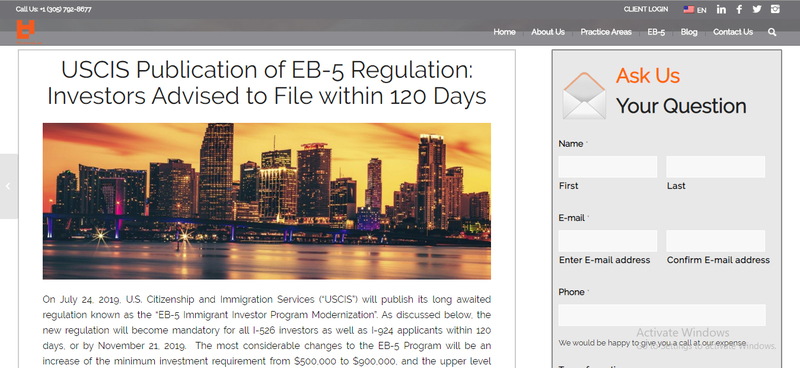USCIS Publication of EB-5 Regulation: Investors Advised to File within 120 Days
On July 24, 2019, U.S. Citizenship and Immigration Services (“USCIS”) will publish its long awaited regulation known as the “EB-5 Immigrant Investor Program Modernization”. As discussed below, the new regulation will become mandatory for all I-526 investors as well as I-924 applicants within 120 days, or by November 21, 2019. The most considerable changes to the EB-5 Program will be an increase of the minimum investment requirement from $500,000 to $900,000, and the upper level investment from $1 million to $1.8 million. Barring any litigation or legislation that would put a hold on the EB-5 Immigrant Investor Program Modernization from becoming mandatory, it will be urgent that all prospective EB-5 investors submit their I-526 petition prior to the effective date, and that all new commercial enterprises (“NCE’s”) finish their capital raises immediately.
When initially proposed on January 11, 2017, the regulations proposed the following changes:
- Increase the standard minimum EB-5 investment amount to $1,800,000, or $1.3 million in a Targeted Employment Area (“TEA”). In other words, the regulation would require that a TEA be distinguished by a 25% reduction of the new $1.8 million investment amount. Existing regulations have required a 50% reduction, from $1 million to $500,000.
- Require that a TEA can only be designated by USCIS, and no longer the state governments. The regulation would provide for a high-unemployment within an MSA, county, city, single census tract, or limited group of census tracts.
- Grant priority date protection to investors with an approved Form I-526 petition, but whose regional centers or projects fail, so that investors could choose to file a new Form I-526 petition while keeping the original priority date (subject to certain restrictions).
- Allow a spouse and children to be able to file Form I-829, even if not included on the principal investor’s petition.
- Other technical changes.
As provided in the final rule to be published in the Federal Register, USCIS considered many comments and suggestions in response to the proposed regulation. In comparison to the proposed changes in 2017, the significant changes in the final regulation will:
- Retain the 50% minimum investment differential between a TEA and a non-TEA project, instead of the differential to 25% as proposed. This is a bittersweet development for investors as it means the minimum investment amount will not be $1.35 million. New I-526 filings will require that investments be increased from $500,000 to $900,000 in a TEA, and $1.8 million in a non-TEA.
- Require that USCIS redetermine every five years whether the investment amount should be increased, specifically beginning October 2, 2024.
- Provide that such that amendments or supplements to any EB-5 offering necessary to maintain compliance with applicable securities laws based upon the changes in the new regulation will not independently result in denial or revocation of a petition, provided a petition meets certain criteria.
- The rule clarifies that a petitioner with multiple approved immigrant petitions for classification as an investor is entitled to the earliest qualifying priority date, which will be the date the petition is properly filed.
- Change how a TEA is calculated. USCIS will now take over the process of determining whether a high unemployment zone qualifies as a TEA, instead of state governments, by prohibiting the large-scale aggregation or “gerrymandering” of geographic census tracts. Superficially, the new regulation will still require that an area of high unemployment have at least 150 percent of the national average unemployment rate, but now it will limit a project to be geographically within one census tract or if the business is situation directly on contiguous census tracts in which the new commercial enterprise is principally doing business. USCIS will no longer allow unlimited aggregation of census tracts, but may only include any or all census tracts directly adjacent to such census tract(s). The weighted average of the unemployment rate for the aggregated census tracts must be at least 150% of the national average unemployment rate.
Following the publication of the regulation, the EB-5 industry, investors, and stakeholders will need to monitor and consider whether federal legislation may pass that can further modify the program. As well, at issue will be whether any federal court will enjoin or strike down the regulation as being in any way “arbitrary and capricious” and whether USCIS is entitled to deference in its interpretation of the federal statutes.
https://www.harrislawpa.com/new-eb5-regulation-increase/
Mentions
States
- New York
Videos





Subscribe for News
Site Digest
Join Professionals on EB5Projects.com →
Securities Disclaimer
This website is for informational purposes only and does not constitute an offer or solicitation to sell shares or securities. Any such offer or solicitation will be made only by means of an investment's confidential Offering Memorandum and in accordance with the terms of all applicable securities and other laws. This website does not constitute or form part of, and should not be construed as, any offer for sale or subscription of, or any invitation to offer to buy or subscribe for, any securities, nor should it or any part of it form the basis of, or be relied on in any connection with, any contract or commitment whatsoever. EB5Projects.com LLC and its affiliates expressly disclaim any and all responsibility for any direct or consequential loss or damage of any kind whatsoever arising directly or indirectly from: (i) reliance on any information contained in the website, (ii) any error, omission or inaccuracy in any such information or (iii) any action resulting therefrom.



